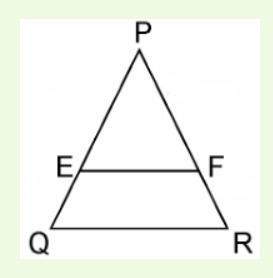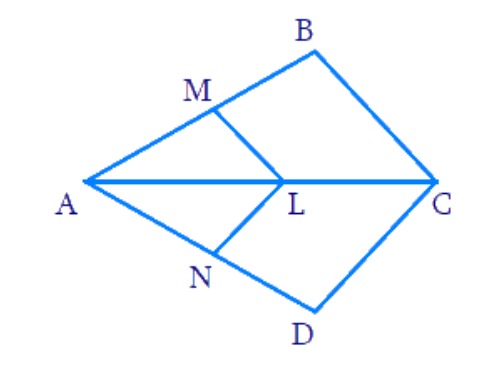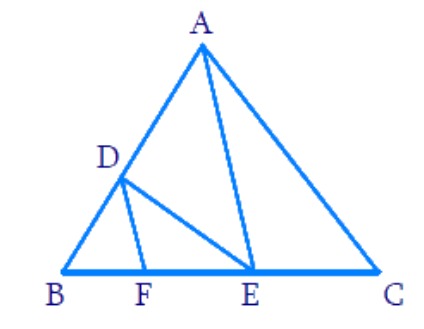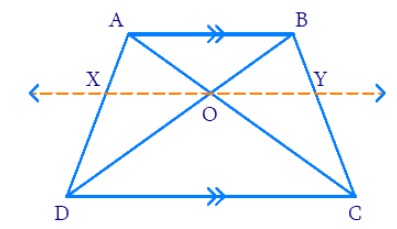Exercise 2
1. In Fig, (i) and (ii), DE || BC. Find EC in (i) and AD in (ii).
(i)

In, ΔABC BC ||
In ΔABC and Δ
∠ABC = ∠
∠ACB = ∠
∠A = ∠
⇒ ΔABC ~ Δ
EC =
EC =
(ii)
(ii) In ΔABC and ΔADE

∠ABC = ∠
∠ACB = ∠
∠A = ∠
ΔABC ∼ Δ
AD =
AD =
2. E and F are points on the sides PQ and PR respectively of a Δ PQR. For each of the following cases, state whether EF || QR:
(i)
(i) PE = 3.9 cm, EQ = 3 cm, PF = 3.6 cm and FR = 2.4 cm
Solution:

Here,
and
Hence,
According to the converse of Basic Proportionality theorem, EF is not parallel to QR.
(ii)
(ii) PE = 4 cm, QE = 4.5 cm, PF = 8 cm and RF = 9 cm
Solution:
Here,
Hence,
AAccording to converse of Basic Proportionality theorem, EF || QR
(iii)
(iii) PQ = 1.28 cm, PR = 2.56 cm, PE = 0.18 cm and PF = 0.36 cm
Solution:
Here, PQ =
EQ = PQ - PE
= (1.28 - 0.18) cm =
PR =
FR = PR - PF
= (2.56 - 0.36)cm =
Now,
⇒
According to converse of Basic Proportionality theorem, EF || QR
if LM || CB and LN || CD, prove that
Solution:

In ΔABC LM ||
In ΔACD LN ||
From equations (1) and (2)
⇒
Adding 1 on both sides
⇒
Hence proved.
4. In Fig, DE || AC and DF || AE. Prove that
Solution:

In ΔABC DE ||
In ΔABE DF ||
From (i) and (ii)
Thus,
5. In Fig, DE || OQ and DF || OR. Show that EF || QR.
Solution:

In ΔPOQ DE ||
[[
In ΔPOR DF ||
From equation (1) and (2)
In ΔPQR
∴ QR || EF (Converse of Basic Proportionality theorem)
6. In Fig, A, B and C are points on OP, OQ, and OR respectively such that AB || PQ and AC || PR. Show that BC || QR.
Solution:

In ΔOPQ, AB ||
In ΔOPR AC ||
From equations (i) and (ii)
Now, In ΔOQR
Thus, BC || QR [By Converse of Basic proportionality theorem]
7. Using Theorem 6.1, prove that a line drawn through the mid-point of one side of a triangle parallel to another side bisects the third side.
Solution:

In ΔABC, D is the midpoint of
Therefore, AD =
Now, DE ||
⇒
⇒
⇒ AE =
Hence, E is the midpoint of
8. Using Theorem 6.2, prove that the line joining the mid-points of any two sides of a triangle is parallel to the third side.
Solution:

In ΔABC, D is the midpoint of
⇒ AD =
E is the midpoint of
AE =
⇒
From equations (i) and (ii)
In ΔABC, according to theorem 6.2 (Converse of Basic Proportionality theorem),
Since,
Thus, DE ||
Hence, proved.
9. ABCD is a trapezium in which AB || DC and its diagonals intersect each other at the point O. Show that
Solution:

In trapezium ABCD, AB ||
Also, AC and BD intersect at ‘O’
Construct XY parallel to AB and CD (XY || AB, XY || CD) through ‘O’
In ΔABC OY ||
According to theorem 6.1 (Basic Proportionality Theorem)
In ΔBCD OY ||
According to theorem 6.1 (Basic Proportionality Theorem)
From equations (1) and (2)
⇒
Hence proved.
10. The diagonals of a quadrilateral ABCD intersect each other at the point O such that
Solution:

In ΔABC, OE ||
⇒
But,
⇒
From equations (1) and (2)
In ΔBCD,
OE ||
We know that, OE ||
Thus, AB ||
Hence we can say ABCD is a trapezium as one pair of opposite sides AB and CD are parallel.
